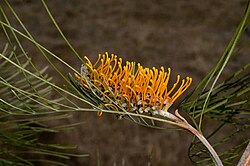Biology:Grevillea pteridifolia
| Golden grevillea | |
|---|---|

| |
| Grevillea pteridifolia in Myall Park Botanic Garden | |
| Scientific classification | |
| Kingdom: | Plantae |
| Clade: | Tracheophytes |
| Clade: | Angiosperms |
| Clade: | Eudicots |
| Order: | Proteales |
| Family: | Proteaceae |
| Genus: | Grevillea |
| Species: | G. pteridifolia
|
| Binomial name | |
| Grevillea pteridifolia Knight[1]
| |
| Synonyms[1] | |
|
List
| |
Grevillea pteridifolia is a species of flowering plant in the family Proteaceae and is endemic to northern Australia. It is also known by many common names, including golden grevillea,[2] silky grevillea,[3] fern-leaved grevillea, golden parrot tree, golden tree, manbulu, yawuny and tjummula.[4] It is a shrub or tree usually with pinnatisect leaves, and bright orange-yellow or reddish flowers.
Description
Grevillea pteridifolia is a shrub or tree that typically grows to a height of 2–14 m (6 ft 7 in–45 ft 11 in), or rarely a prostrate shrub. Its leaves are 100–450 mm (3.9–17.7 in) long and usually pinnatisect with 13 to 29 linear or very narrowly egg-shaped lobes 150–250 mm (5.9–9.8 in) long and 1–4 mm (0.039–0.157 in) wide. The edges of the leaves are rolled under, the exposed parts of the lower surface covered with silky hairs. The flowers are arranged in clusters on one side of a rachis 80–220 mm (3.1–8.7 in) long, the flowers at the base of the cluster opening first. The flowers are greyish-green to silvery on the outside, the inside and the style bright orange-yellow or reddish, the pistil 23–36 mm (0.91–1.42 in) long. Flowering occurs in most months with a peak from May to September and the fruit is a shaggy-hairy follicle 14–21 mm (0.55–0.83 in) long.[2][3]
Plants from Queensland are non-lignotuberous shrubs to small trees with smooth bark and lighter inflorescences than other forms. A prostrate form which spreads up to 5 m (16 ft) across is found on exposed areas near Cooktown in north Queensland. Plants from Western Australia and the Northern Territory grow as a rough-barked lignotuberous shrub to small tree. A population of this last form from Kakadu National Park has all-silvery leaves.[4]
Taxonomy
Grevillea pteridifolia was first collected by Europeans from the vicinity of the Endeavour River sometime around 10 June and again from Lookout Point around 4 August 1770 by Joseph Banks and Daniel Solander, naturalists on the Endeavour during Lieutenant (later Captain) James Cook's first voyage to the Pacific Ocean.[5] However, the description of the species was not published until Joseph Knight described it in his 1809 work On the cultivation of the plants belonging to the natural order of Proteeae as Grevillia Pteridifolia (the "Pteris-leaved Grevillia").[6][7] The following year Robert Brown gave it the name Grevillea chrysodendron in his work Prodromus Florae Novae Hollandiae et Insulae Van Diemen.[8]Cite error: Closing </ref> missing for <ref> tag Grevillea 'Honey Gem' is a cross with a red form of Grevillea banksii.[9] Similar to 'Honey Gem' is G. 'Winter Sparkles', another hybrid of G. pteridifolia and G. banksii.[10]
The leaves were used as stuffing and as a herb when cooking emu by the Aborigines on Groote Eylandt, and used by early settlers to stuff pillows.[4]
A series of compounds with antibacterial activity, called the kakadumycins, have been isolated from a streptomycete recovered from G. pteridifolia.[11]
References
- ↑ 1.0 1.1 "Grevillea pteridifolia". Australian Plant Census. https://biodiversity.org.au/nsl/services/apc-format/display/111324.
- ↑ 2.0 2.1 "Grevillea pteridifolia". Australian Biological Resources Study, Department of Agriculture, Water and the Environment: Canberra. https://profiles.ala.org.au/opus/foa/profile/Grevillea%20pteridifolia.
- ↑ 3.0 3.1 "Grevillea pteridifolia ". FloraBase. Western Australian Government Department of Parks and Wildlife. https://florabase.dpaw.wa.gov.au/browse/profile/2076.
- ↑ 4.0 4.1 4.2 Olde, Peter; Marriott, Neil (1995). The Grevillea Book Volume 3. Australia: Kangaroo Press. pp. 114–16. ISBN 0864176112.
- ↑ *Olde, Peter; Marriott, Neil (1995). The Grevillea Book, vol 1. Sydney: Kangaroo Press. pp. 12–13. ISBN 0-86417-325-3.
- ↑ "Grevillea psilantha". APNI. https://id.biodiversity.org.au/instance/apni/543828.
- ↑ Knight, Joseph (1809). On the Cultivation of the Plants Belonging to the Natural Order of Proteeae. London: W. Savage, printer. https://archive.org/details/oncultivationpl00kniggoog/page/n145/mode/2up. Retrieved 26 October 2022.
- ↑ "Grevillea chrysodendron". APNI. https://id.biodiversity.org.au/instance/apni/523111.
- ↑ "Grevillea 'Honey Gem'". List of Registered Cultivars derived from Australian native flora. Australian Cultivar Registration Authority. http://www.anbg.gov.au/acra/descriptions/acc178.html.
- ↑ "Grevillea 'Winter Sparkles'". List of Registered Cultivars derived from Australian native flora. Australian Cultivar Registration Authority. http://www.anbg.gov.au/acra/descriptions/acc497.html.
- ↑ Castillo, U (July 2003). "Kakadumycins, novel antibiotics from Streptomyces sp NRRL 30566, an endophyte of Grevillea pteridifolia". FEMS Microbiology Letters 224 (2): 183–190. doi:10.1016/s0378-1097(03)00426-9. PMID 12892881.
| Wikimedia Commons has media related to Grevillea pteridifolia. |
Wikidata ☰ Q5608007 entry
 |


